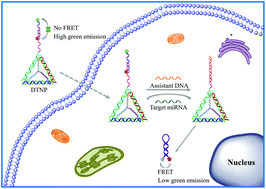A DNA tetrahedron nanoprobe-based fluorescence resonance energy transfer sensing platform for intracellular tumor-related miRNA detection†
Abstract
Accurate and sensitive detection of disease-related microRNAs (miRNAs) is of great significance for early disease diagnosis. In this work, a DNA tetrahedron nanoprobe (DTNP)-based fluorescence resonance energy transfer (FRET) sensing platform (termed DTNP sensor) was constructed for sensitive detection of tumor-related miRNA (e.g., hsa-miR-146b-5p) with DNA assisted cyclic amplification. DTNP was synthesized by DNA self-assembly. In the absence of hsa-miR-146b-5p, the fluorescence DNA (HP) modified with FAM at the 5′ terminal and TAMRA at the 3′ terminal cannot form the hairpin structure because of the hybridization with the extended DNA strand of the DNA tetrahedron, resulting in a low FRET effect. In the presence of hsa-miR-146b-5p, it would complementarily hybridize with the extended DNA strand of the DNA tetrahedron, leading to the release of HP and occurrence of strong FRET. Thus, the concentration of hsa-miR-146b-5p can be revealed by the change in the fluorescence intensity. Moreover, an assistant DNA was employed to replace hsa-miR-146b-5p for cyclic signal amplification, which can further enhance the detection sensitivity. Under the optimal experimental conditions, the limit of detection for hsa-miR-146b-5p was as low as 6 pM (S/N = 3). Furthermore, the DTNP sensor was successfully applied to evaluate the hsa-miR-146b-5p expression levels in different cell lines. The inhibition of hsa-miR-146b-5p expression in different cells was also investigated and a satisfactory result was obtained.



 Please wait while we load your content...
Please wait while we load your content...